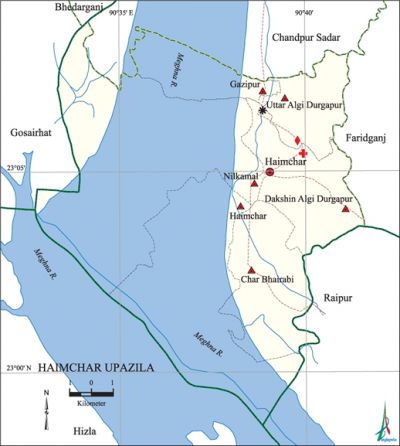Haimchar Upazila
Haimchar Upazila (chandpur district) area 174.49 sq km, located in between 23°00' and 23°10' north latitudes and in between 90°32' and 90°42' east longitudes. It is bounded by chandpur sadar and bhedarganj upazilas on the north, hizla upazila on the south, raipur and faridganj upazilas on the east, gosairhat upazila on the west.
Population Total 125108; male 63446, female 61662; Muslim 119146, Hindu 5958 and others 4.
Water bodies Main river: meghna.
Administration Haimchar Thana was formed in 1976 and it was turned into an upazila in 1984.
| Upazila | ||||||||
| Municipality | Union | Mouza | Village | Population | Density (per sq km) | Literacy rate (%) | ||
| Urban | Rural | Urban | Rural | |||||
|
- |
6 |
28 |
59 |
15857 |
109251 |
717 |
45.94 |
39.46 |
| Upazila Town | ||||||||
|
Area |
Mouza |
Population |
Density |
Literacy rate | ||||
|
11.2 |
2 |
15857 |
1416 |
45.22 | ||||
| Union | ||||
| Name of union and GO code | Area (acre) | Population | Literacy rate (%) | |
| Male | Female | |||
|
Uttar Algi Durgapur 11 |
5003 |
15119 |
15181 |
51.53 |
|
Dakshin Algi Durgapur 23 |
4730 |
15570 |
15598 |
47.82 |
|
Gazipur 59 |
2789 |
2143 |
1803 |
20.61 |
|
Char Bhairabi 35 |
2569 |
15749 |
15505 |
34.32 |
|
Nilkamal 71 |
10551 |
13200 |
12186 |
29.83 |
|
Haimchar 47 |
7512 |
1665 |
1389 |
17.79 |
Source Bangladesh Population Census 2001, Bangladesh Bureau of Statistics.

Archaeological heritage and relics Three domed mosque and ancient graveyard at Bhingulia.
Religious institutions Mosque 151, temple 18, tomb 4, sacred place 1. Noted religious institutions: Char Bhairabi Jami Mosque, Khandaker Bari Mosque, Jagannath Bari Mandir (Haimchar), Shree Shree Hari Mandir (Char Bhairabi) and Shree Shree Raskhakali Mandir.
Literacy rate and educational institutions Average literacy 40.29%; male 42.29%, female 38.26%. Educational institutions: college 1, secondary school 10, primary school 60, madrasa 26. Noted educational institutions: Charbhanga High School (1910), Bajapti Ramani Mohan High School (1918), Nilkamal Osmania High School (1928), Haimchar Government Girls' High School, Haimchar Government Boys' High School, MJS Girls' High School, KVN High School, Durgapur High School, Char Bhairabi High School, Charsholdi KB Government Primary School (1837).
Cultural organisations Library 2, theatre group 1, cinema hall 3, club 29, women's organisation 1.'
Main sources of income Agriculture 64.37%, non-agricultural labourer 3.22%, industry 0.63%, commerce 15.01%, transport and communication 1.52%, service 6.54%, construction 0.86%, religious service 0.32%, rent and remittance 0.11% and others 7.42%.
Ownership of agricultural land Landowner 50.14%, landless 49.86%; agricultural landowner: urban 33.18% and rural 52.50%.'
Main crops Paddy, jute, wheat, betel leaf, onion, garlic, sayabin, potato, karalla.
Extinct or nearly extinct crops Kaun, sesame, linseed, mustard, sweet potato, tobacco, kalijira, arahar and khesari (pulse).
Main fruits Jackfruit, betel nut, mango, blackberry, banana, palm, wood-apple, papaya, amra, chalta, shaddock,, plum, coconut.
Fisheries, dairies and poultries Fishery 127, artificial breeding centre 1,' poultry 10, nursery 14.
Communication facilities Pucca road 15 km, mud road 195 km; waterway 12 nautical miles.
Extinct or nearly extinct traditional transport Palanquin, bullock cart.
Noted manufactories Rice mill, saw mill, ice factory.
Cottage industries Goldsmith, cane work, bamboo work, wood work.
Hats, bazars and fairs Hats and bazars are 14, fairs 4, most noted of which are Char Bhairabi, Haimchar and Katakhali Bazar, Baishakhi Mela, Paush Parban Mela and Rath Mela.
Main exports Jute, betel leaf, onion, garlic, coconut,' betel nut, karalla, fish.
Access to electricity All the unions of the upazila are under rural electrification net-work. However 15% (urban 15.86% and rural 14.88%) of the dwelling households have access to electricity.
Sources of drinking water Tube-well 78.66%, tap 0.57%, pond 13.39% and others 7.38%.
Sanitation 39% (rural 37.56% and urban 49.31%) of dwelling households of the upazila use sanitary latrines and 51.80% (rural 52.71% and urban 45.52%) of dwelling households use non-sanitary latrines; 9.20% (rural 9.73% and urban 5.38%) of households do not have latrine facilities.
Health centres Upazila health complex 1, family welfare centre 2, satellite clinic 1.
NGO activities Operationally important NGOs are caritas, brac, Disha. [Md. Mahbubur Rahman]
References Bangladesh Population Census 2001, Bangladesh Bureau of Statistics; Cultural survey report of Haimchar Upazila 2007.
